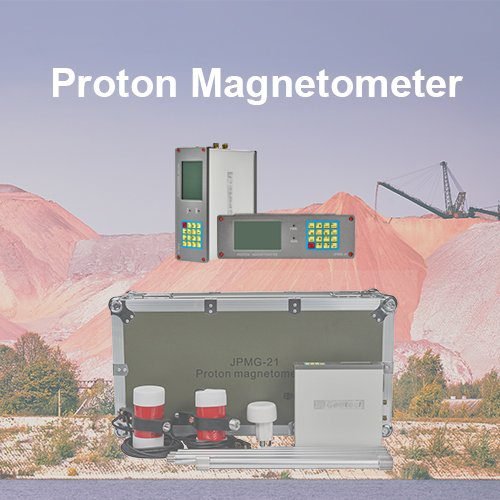Welcome to Geotech!

Electromagnetic Detectors: Unveiling the Hidden Treasures Beneath the Surface
I. Introduction
Electromagnetic Detectors are advanced instruments used to measure changes in subsurface electromagnetic fields. By inducing electromagnetic fields and measuring the resulting secondary fields, these detectors provide valuable insights into subsurface structures. This article explores the principles, methods, applications, and advantages of electromagnetic detectors, offering a comprehensive guide for professionals and decision-makers.

II. Definition and Principle of Electromagnetic Detectors
Electromagnetic Detectors operate based on Faraday’s Law of Electromagnetic Induction. They measure the electromagnetic field changes induced in subsurface materials to generate images of underground structures. When subsurface materials are subjected to an external electromagnetic field, eddy currents are generated, which in turn produce secondary electromagnetic fields. By measuring these secondary fields, electromagnetic detectors can infer the resistivity and conductivity distribution of subsurface materials.
III. Key Methods of Electromagnetic Detection
Electromagnetic detection technology includes various methods, such as Time-Domain Electromagnetics (TDEM) and Frequency-Domain Electromagnetics (FDEM). Each method has its advantages and is suitable for different applications.
(1) Time-Domain Electromagnetics (TDEM)
TDEM involves applying pulse currents and measuring the decay of voltage responses to obtain electromagnetic properties of subsurface materials. This method is particularly effective for deep geological exploration and mineral detection.
(2) Frequency-Domain Electromagnetics (FDEM)
FDEM applies alternating currents at different frequencies and measures the responses to assess the conductivity of subsurface materials. This method is suitable for shallow geological exploration and environmental monitoring.
IV. Applications of Electromagnetic Detectors
Electromagnetic detectors are extensively used in the following fields:
- Hydrogeological Surveys: Locating and characterizing aquifers, assessing groundwater reserves and quality.
- Environmental Monitoring: Tracking the spread of groundwater pollution and evaluating its impact on underground water resources.
- Engineering Surveys: Evaluating foundation stability and groundwater levels in construction projects to prevent water-related risks during construction.
- Agricultural Irrigation: Identifying underground water resources suitable for agricultural irrigation to improve water use efficiency.
- Mining Exploration: Investigating groundwater conditions around ore bodies and assessing the impact of mining activities on groundwater.
V. Comparison with Other Geophysical Methods
(1) Comparison with Ground-Penetrating Radar
- Advantages: GPR offers high resolution for shallow geological exploration and rapid data acquisition.
- Limitations: Limited application in deep exploration and complex geological conditions, and relatively high cost.
- Best Application Scenarios: Suitable for detecting shallow aquifers, underground voids, and fractures.
(2) Comparison with Seismic Method
- Advantages: Seismic methods provide high accuracy for deep geological exploration and detailed information on geological layers.
- Limitations: Complex equipment, high operational costs, and lower efficiency for shallow aquifer detection.
- Best Application Scenarios: Suitable for deep aquifer and complex geological structure exploration.
(3) Comparison with Magnetic Method
- Advantages: Magnetic methods are simple to operate, cost-effective, and capable of rapid data acquisition over large areas.
- Limitations: Limited direct detection capability for groundwater, mainly used for geological structure and ore body detection.
- Best Application Scenarios: Suitable for regional geological structure surveys and ore body detection.
(4) Advantages of Combined Surveys
Integrating electromagnetic detectors with other geophysical methods can leverage the strengths of each, enhancing the accuracy and efficiency of groundwater resource exploration. For example, combining electromagnetic detectors with GPR provides high-resolution geological information from shallow to deep, while the joint application of seismic and magnetic methods enhances deep geological structure detection capabilities.
VI. Advantages and Limitations of Electromagnetic Detectors
(1) Advantages
- Non-Contact Detection: Electromagnetic detectors do not damage the subsurface environment, making them an eco-friendly exploration technology.
- High Precision: Electromagnetic detectors provide detailed subsurface structural information, enabling precise aquifer identification.
- Flexibility: Electromagnetic detectors are suitable for various geological conditions and environments, capable of working in different terrains and climates.
- Cost-Effective: Compared to traditional drilling methods, electromagnetic detectors offer lower usage costs and can quickly acquire extensive geological information.
(2) Limitations
- Data Interpretation Complexity: Professional knowledge and experience are required to interpret data from electromagnetic detectors, especially in complex geological conditions where uncertainties may exist.
- External Interference: Electromagnetic detectors are susceptible to electromagnetic noise from external sources such as power lines and communication cables, which can affect data quality and accuracy.
- Depth Limitations: Although electromagnetic detectors can detect subsurface structures to a certain depth, they may not be sufficient for deep aquifer exploration in some cases.
VII. Case Studies
(1) Case Study 1: Groundwater Pollution Monitoring in an Industrial Area
In an industrial zone, electromagnetic detector technology was used to monitor the spread of groundwater pollution. Through electromagnetic detector technology, the distribution and migration pathways of the pollution plume were successfully mapped, providing scientific evidence for pollution remediation. Additionally, ground-penetrating radar was combined to further confirm the details of pollution spread in shallow layers, supporting the development of effective remediation plans.
(2) Case Study 2: Groundwater Exploration in an Arid Region
In an arid region with scarce water resources, traditional drilling methods were costly and inefficient. By combining electromagnetic detector technology with Induced Polarization (IP) methods, electromagnetic detector technology quickly identified several potential aquifer locations. Subsequent drilling verification confirmed that these locations had abundant groundwater reserves and good water quality, providing a vital water source for local agricultural irrigation and residential use.
VIII. Company Product Introduction
As a leading enterprise in geophysical exploration, we are proud to introduce the GIM Series, a multi-functional electrical exploration device. The GIM Series integrates natural potential measurement, 1D/2D/3D resistivity imaging (ERT), and induced polarization (IP) capabilities, offering a comprehensive solution for electromagnetic detection.
(1) Product Features
- High-Precision Data Acquisition: 24-bit high-precision A/D conversion ensures accurate and reliable data for precise subsurface imaging.
- Depth Breakthrough: Bi-directional cascading technology overcomes traditional depth limitations in electrical exploration, achieving a detection depth of 1,500 meters to meet the needs of deep aquifer exploration.
- Strong Environmental Adaptability: With an IP67 waterproof design and a wide operating temperature range of -20°C to +60°C, the device ensures stable performance in extreme environments, whether in hot deserts or cold mountainous regions.
- Multi-Scenario Application: From groundwater pollution monitoring to ore body location, the GIM Series supports cross-hole, underwater, and 3D distributed cabling, making it suitable for various complex geological conditions and application scenarios.
- Efficient Data Collection: 10-channel synchronous acquisition + rolling measurement mode allows for the capture of multi-electrode data in a single setup, significantly improving work efficiency and reducing on-site working time.
- Data Compatibility: Data exported in TXT/Excel formats are compatible with mainstream inversion software (e.g., Res2DInv, EarthImager), facilitating further data processing and analysis by users.
(2) Success Cases
The GIM Series has performed excellently in numerous projects, successfully assisting clients in efficiently locating and exploring groundwater resources. For example, in a groundwater pollution monitoring project, the GIM Series used ERT technology to quickly and accurately map the distribution of the pollution plume, providing critical data support for pollution remediation. In a mining exploration project, the GIM Series, combined with IP methods, successfully detected groundwater conditions around ore bodies, offering important references for mining plans.
IX. Future Outlook
With continuous technological advancements, electromagnetic detector technology is set to embrace new opportunities in the following areas:
- Technology Integration: Further integration of multiple geophysical methods, such as ERT, IP, and GPR, to achieve more efficient and accurate groundwater resource exploration.
- Intelligent Development: Incorporating artificial intelligence and machine learning technologies to enhance the automation and accuracy of data interpretation, reducing human errors.
- Environmental and Sustainability Focus: Greater emphasis on environmental protection during exploration, developing more energy-efficient and eco-friendly devices to support sustainable water resource management.
- Interdisciplinary Collaboration: Strengthening cooperation with disciplines such as hydrology, geology, and environmental science to jointly advance the development and application of groundwater resource exploration technologies.
X. Conclusion
As an essential tool in modern geophysical exploration, electromagnetic detectors are playing an increasingly important role in the rational development and protection of underground water resources. Through continuous technological innovation and practical applications, we believe that electromagnetic detector technology will make a greater contribution to addressing global water resource issues in the future. Choosing our GIM Series is choosing a reliable partner to explore the endless possibilities of underground water resources with us.
Reference
- Society of Exploration Geophysicists (SEG) https://seg.org/
- Society of Environmental and Engineering Geophysicists (EEGS) https://www.eegs.org/
- Geology and Equipment Branch of China Mining Association http://www.chinamining.org.cn/
- International Union of Geological Sciences (IUGS) http://www.iugs.org/
- European Geological Survey Union (Eurogeosurveys) https://www.eurogeosurveys.org/
-1.png)


